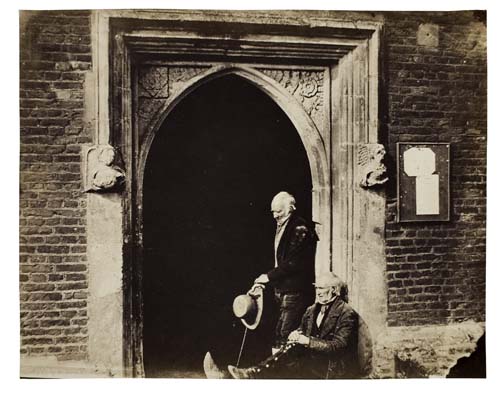Sale 2135 - Lot 26
Unsold
Estimate: $ 25,000 - $ 35,000
WINTER, JOHN (active 1850s)
British album containing 49 early photographic prints, with beautifully rendered scenes of Cambridge, the Isle of Wight, the villages of Tottenham, South Gate and Richmond; still lifes of fowl, as well as smaller portraits (including the photographer?). Salted paper (24) and albumenized salt and albumen (25) prints, a few from calotype negatives, 4x3 1/2 (10.1x8.8 cm.) to 6x8 1/4 inches (15.2x20.9 cm.), the medium-format prints mounted one per leaf, most with a handwritten caption below. 4to, morocco-backed boards; with bookplate of Thomas L. M. Winter (the photographer's brother); all edges gilt. 1853-1856
British album containing 49 early photographic prints, with beautifully rendered scenes of Cambridge, the Isle of Wight, the villages of Tottenham, South Gate and Richmond; still lifes of fowl, as well as smaller portraits (including the photographer?). Salted paper (24) and albumenized salt and albumen (25) prints, a few from calotype negatives, 4x3 1/2 (10.1x8.8 cm.) to 6x8 1/4 inches (15.2x20.9 cm.), the medium-format prints mounted one per leaf, most with a handwritten caption below. 4to, morocco-backed boards; with bookplate of Thomas L. M. Winter (the photographer's brother); all edges gilt. 1853-1856
Additional Details
John Winter was curate at All Hallows Parish Church in Tottenham, which is located only a few miles from London. An enthuasiastic and accomplished amateur photographer, Winter focused his lens on the lush landscapes in which local churches might be found and the proto-modernist forms of bridges. His more traditional pictures include portraits and still lifes. Winter's keen sense of composition and technical printing skills encompasssed both salted paper and albumen printing at a transitional era in photographic history.
Interestingly, Winter's album coincides with the important period when Fox Talbot's salted paper print was being replaced by the collodion (albumen) process. Frederick Scott Archer published the results of a new collodion process in "The Chemist" (March 1851), discussing its advantages and offering instructions on how to use it.
Fox Talbot immediately took action, claiming that Archer's process was covered by his own Calotype patent. Despite public criticism of Fox Talbot's suits against photographers, his actions successfully prevented practitioners from using the collodion process without obtaining a license from him. Subsequently, he initiated an action against photographer Martin Silvester La Roche. According to Archer historian Seán MacKenna, "The court concluded, in a milestone ruling, that while Talbot was the inventor of the calotype process, La Roche was not guilty of infringing on the calotype patent by taking collodion portraits."
In 1854, Archer published a manual on the process entitled "The Collodion Process on Glass." Although Archer was recognized as the inventor of the collodion process--which popularized photography worldwide--he died in obscurity and penniless.
Obviously fascinated with the medium of photography, Winter showed aptitude in his employment of both the salted paper and albumen techniques. His lyrical photographs of thatched rooftops on the Isle of Wight and strong pictures of Tottenham's Vicarage were rendered using both the salted paper and albumen processes, resulting in unique visual interpretations reflecting the particular aesthetic qualities of each paper stock.
Only two albums of Winter's work are extant: this one, and a second that was the subject of an article by Derrick Woods in "The New Zealand Journal of Photography," May 1995, 12-15.
JPGS are available upon request.
Interestingly, Winter's album coincides with the important period when Fox Talbot's salted paper print was being replaced by the collodion (albumen) process. Frederick Scott Archer published the results of a new collodion process in "The Chemist" (March 1851), discussing its advantages and offering instructions on how to use it.
Fox Talbot immediately took action, claiming that Archer's process was covered by his own Calotype patent. Despite public criticism of Fox Talbot's suits against photographers, his actions successfully prevented practitioners from using the collodion process without obtaining a license from him. Subsequently, he initiated an action against photographer Martin Silvester La Roche. According to Archer historian Seán MacKenna, "The court concluded, in a milestone ruling, that while Talbot was the inventor of the calotype process, La Roche was not guilty of infringing on the calotype patent by taking collodion portraits."
In 1854, Archer published a manual on the process entitled "The Collodion Process on Glass." Although Archer was recognized as the inventor of the collodion process--which popularized photography worldwide--he died in obscurity and penniless.
Obviously fascinated with the medium of photography, Winter showed aptitude in his employment of both the salted paper and albumen techniques. His lyrical photographs of thatched rooftops on the Isle of Wight and strong pictures of Tottenham's Vicarage were rendered using both the salted paper and albumen processes, resulting in unique visual interpretations reflecting the particular aesthetic qualities of each paper stock.
Only two albums of Winter's work are extant: this one, and a second that was the subject of an article by Derrick Woods in "The New Zealand Journal of Photography," May 1995, 12-15.
JPGS are available upon request.

Exhibition Hours
Exhibition Hours
Aliquam vulputate ornare congue. Vestibulum maximus, libero in placerat faucibus, risus nisl molestie massa, ut maximus metus lectus vel lorem.


